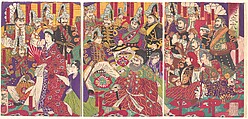Civil and Military Officers
Toshimasa Japanese
Not on view
Looming in the central panel in Japanese dress is Saigo Takamori (1827–1877), the popular hero and influential samurai from Satsuma in Southern Kyushu. His daughter Ayako appears in the left panel. Immediately following the Meiji Restoration in 1868, there was much discontentment, particularly among the samurai who had lost all of their earlier prestige and privileges. Many Satsuma samurai far to the west were among the most reactionary, and when swords were prohibited in January 1877, their hatred of the government came to a head. The famous Satsuma Rebellion broke out in early 1877 under Saigo's leadership and lasted six months, with the fighting confined to Satsuma, itself. Saigo was wounded and at his own request, decapitated on the battlefield. His 40,000 samurai, traditionally the country's military elite had been defeated by an equal number of soldiers drafted into the newly-formed conscript army.
Due to rights restrictions, this image cannot be enlarged, viewed at full screen, or downloaded.

